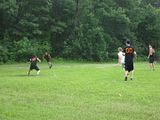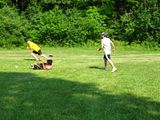 | Coffee Time | |
| by Carl Coffee |
5 "Wacky" Rules for Wiffling in WSEM
For my second Coffee Time discussion I am talking about the unique rules of Wiffle in Southeast Michigan. This is to benefit league veterans who have wondered where these rules came from, and to help the rookies, who may be a bit confused by them, get a handle on them. Wiffleball is such a different game than baseball or softball, and rules can change drastically from one wiffle league to another. We formed our rules by taking rules from tournaments we have played in, rules we read about and found awesome, and the products of our own creative minds.
First off, wiffleball is usually played one of two ways: slow/medium pitch with base running, or fast pitch without base running. Well, right off the bat you can see how different we are, because we are a fast pitch league with base running. Pitchers can throw as fast or as slow as they want, which I believe is the only way to play the game. A wiffleball field without bases, instead using lines to determine whether a hit is a single, double, or triple, looks incredibly silly and amateurish. I never see us changing the fast-pitch/base-running style of play.
This next rule is easily our most popular and exciting: our first pitch strike out rule! If I have asked 100 people about this rule, I would say 99 out of the 100 love it. It speeds up the game, but more importantly it creates excitement that few sports rules can. It's very simple: if the pitcher hits the strike zone board on the first pitch of an at bat and the batter does not swing, they are out. I found this after reading the rules of the Wiffleup Tournaments (http://www.wiffleup.com/). When I read about it, we tested it out and instantly knew it was a keeper. For the new players who have never played with this rule, you are probably thinking it isn't a big deal, well, any of our veterans will tell you differently. In baseball, the most exciting count is of course the 3-2 count. Well in our league, the most exciting count is the 0-0 count. No pitch is more important than the first, and the best pitchers in our league take advantage of it. Pitchers who have a reputation of being accurate, will more times than not start with an 0-1 count (more on our count a couple paragraphs down). The batters will be swinging away to avoid being one and done. Something that I find funny is when a pitcher throws a beauty of a first pitch that hits the board and the batter takes a lame looking, half cut swing, the batter’s teammates usually always cheer him on,"nice swing". Yes, the batter looked like a fool, but he is still alive in the at bat. Striking out on the first pitch happens to everyone, the good hitters and the bad, so don't feel bad when it happens to you.

Pitcher, Chad Hoppe, surprises Ryan Davis with a
breaking ball on the outside corner with the first pitch.
The first rule I want to write about here is our unique force out rule. We use this rule because it was the rule at the first competitive tournament we ever played in, London, OH (http://www.londonwiffleball.com/). Wiffleball is obviously not baseball or softball, so fielding a 1st baseman is a crazy idea. Instead, there is a five foot radius circle around the pitcher's mound for force outs. We are not unique to have a giant circle around the pitcher's mound, however, most leagues use that as an out ONLY to 1st base. WSEM uses the circle to get all force outs for the lead runner. The rule officially reads as this: The force out in the pitcher's circle applies to the lead-runner. However, if the lead runner beats the throw to the bag, the rule “waterfalls" back through the bases. So, if the trailing runner doesn't beat the throw, then the force out applies to that trailing runner. Only one out may be recorded in the pitcher's circle per play. You really have to be on your toes on offense and on defense. A bases loaded situation with one out in our league is not as scary of a situation as it would be in a league that only uses the pitcher's circle as an out to 1st base. A lot of the top offensive players in our league are the fearless base-runners who turn singles into doubles, or go from 1st to 3rd on a base hit so they can be immune from being a force out. It's a fun rule that helps out the defense immensely, and also creates many exciting situations for the offense.

The Warriors attempt to make an out in the pitchers' circle. Since
the runner has rounded second, the force play will be at first base.
Another way to get base runners out is our rarely made use of pegging rule, or I should say our lack of pegging rule… or limited pegging rule. In most, if not all base running wiffleball leagues, pegging is a staple. We, however, only allow pegging from 3rd base to home. This is another rule we took from London Wiffleball. Just like the force out rule, it has just stuck after all these years, and we like it this way. We know wiffleball has its wacky rules and we sure have a few of our own, so you would think we would have no problem pegging base runners. Once again we love to be different, so of course our pegging rule is much different than most leagues. I've played in a few tournaments that do allow pegging, and I believe it makes the game very messy. If wiffleball was art, then pegging would be "finger painting". We like our outs to be pretty and look like baseball: thrown from one defensive player to another, whether it's to the player in the pitchers’ circle, or to a player standing on a base. Although it rarely happens successfully, pegging is attempted from time to time when a runner is on his way home. So for you wifflers who love to peg out a runner, you aren't completed ignored. I guess the reason why we keep the rule this way is simple, we need to help out the offense sometime! The first two rules I wrote about are very much to the advantage of the defense, so we needed to even things out somehow.
Our ball-strike count rule is simple, yet still quite unique. It is a rule that once again is to the advantage of the defense, 5 balls for a walk, and 2 strikes for an out. We have tried all kinds of different counts in wiffleball. From the traditional 4-3, to changing to a 5-3, and I think we even at one time played with a 6-2? Nothing is worse than a game filled with walk after walk. A windy day or having an inexperienced pitcher can make a game unbearable to play in or watch. Combined with our unique first pitch rule, a 5 balls for a walk, and 2 strikes for an out rule speeds the game along very nicely, and keep the batter engaged for every pitch; he is not able to look for and wait on a specific pitch.
The last rule is our most frequently changed, while probably the least used on the field: our tag up rule. We used to let base runners tag up from any base on a caught fly ball. Now, we only allow runners to tag from 3rd to home. The changes to the rule don’t stop there. In 2010 halfway from 3rd to home there was a line. On a pop fly when the runner is tagging up from 3rd base, if the pitcher or any other fielder got the ball in the pitchers’ circle, and the runner’s entire body had NOT completely crossed the line, the play was dead and the runner had to return to 3rd base. If the runner had crossed the line, then you either had to peg him or tag him before he touched home. The Hoppe’s in their September tournament shook it up a bit and added some spice to the rules of this play, making it so that if you are able to throw the ball and hit the strike zone board before the runner touches home, then the runner is out. We like the addition of being able to hit the board as another way to get the tagged up runner out, and are carrying it over into league play in 2011. However, we’re changing the tag up rule once again by removing the halfway line. The reason we’re doing this is to simplify play and make the game run smoother. Having to notice if the runner had crossed the line is just one more thing someone has to pay attention to, and more often than not, no one had a sure look, which can lead to arguments, slowing the game down. Without the line, all players need to concentrate on is the runner, the plate, and the board: all conveniently in one spot. Less confrontation, more action!

Pretend Jason Stanley made this great diving catch and is quickly getting
the ball in to the pitchers circle. In 2010 this would have been
a dead ball. In 2011 his only play will be to peg the runner or the board.
These rules have been critiqued many times, even during the writing of this article, and probably will be critiqued again in the future. Some people love our rules, some people dislike them, and some are just left confused by them. One thing Brandon and I talked about was having certain rules be flexible, so a team with their own home field could adjust them to their liking. Certain rules such as the force outs, the first-pitch strikeout, and the 5-2 count would be the same at every field. Rules such as the tag-up rule, though, and maybe even pegging, might be something that a home team could change. That is something we will talk about at our winter meeting. I hope this helped everyone out a bit. Stay warm, winter is half over!
-
Carl Coffee
Flying Squirrels, 18, SS
Commissioner,
A Tourney General












No comments:
Post a Comment
Please, sign your name to your comments.